Pterois volitans and P. miles
Native range: Indo-Pacific and Red Sea
Invasive range: East Coast of the United States and Caribbean Sea
Impacts: Lionfish can reduce the abundance of small native fish by up to 95% on some coral reefs. Reducing lionfish numbers and restoring populations of native fish can be challenging, given the lionfish’s ability to inhabit diverse habitats. High recruitment pressure from lionfish can create permanent alterations to native reef fish communities.
Some say that the invasion started in Miami, when Hurricane Andrew smashed an aquarium tank in 1992. But you can’t blame the weather: records of wild lionfish in Florida date back at least to 1985. This popular aquarium fish may have been released by fish enthusiasts tired of having a relentless predator in the living rooms, silently dispatching their other fish. And now that exotic predator is spreading north to New England, south to Panama and throughout the Caribbean, feasting on juvenile snapper and grouper along with algae-eating parrotfish as they go–-species which help keep reefs healthy. The lionfish is the first marine fish invasion in the western Atlantic.
Marine biologists are shocked at the speed of their spread in just a decade and at their population densities. Few fish species have established in the wild, let alone so successfully. Suddenly, they’re an abundant reef fish from the Bahamas to Rhode Island. Overfishing of predators like the grouper may be part of the story. Reef destruction and trophic cascade are possible outcomes. The only range limits appear to be colder and fresher waters.
A female lionfish produces two million eggs a year, so not only does it seem unlikely the species can be successfully eradicated, even slowing the growth rate is a challenge. Because lionfish eat just about anything that fits in their mouth while larger native fish don’t seem to recognize lionfish as prey, some experts say humans are the only predators left to call upon.
As of 2010, the Florida Keys National Marine Sanctuary has given out licenses to divers to kill the species inside the property. Reef Environmental Education Foundation (REEF) hosts a series of “Lionfish Derbies” offering prize money largest, smallest, and highest number caught; and publishes the Lionfish Cookbook, aimed at introducing chefs to what NOAA calls a “delicious, delicately flavored fish” similar in taste to snapper and texture to grouper. Lionfish have venomous fin spines––an uncommon feature on East Coast species–-making them top predators and a danger to fishermen and divers. (And more expensive than many other fish on the menu–someone has to remove those venomous spines.)
Wary of eating a venomous fish? Once the spines are removed, it can be prepared as any other fish–you can fry it or serve it as ceviche. You can grill it. You can jerk it.
The Cuban government promoted harvesting lionfish in 2011–and when we visited in 2014, we saw only one pez león over five days of snorkeling on the reefs. Although the invaders persist in deeper waters, the fishing pressure appears to be working.
In 2016, Whole Foods starting selling lionfish filets in its West Coast stores. The time, it appears, has come for this invader to go commercial.
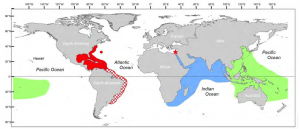
Native range of Pterois volitans (green) and P. miles (blue). Star in Mediterranean Sea denotes migration through the Suez canal. Red is the current nonnative range, red hatching predicted future range.
Links
Great web portal on invasive lionfish, including an invasion timeline and lionfish jewelry from Belize.
Learn more at NOAA’s lionfish profile, and visit REEF’s lionfish program page.
Paul Greenberg reports from the field for Food and Wine here.
Looking for gear for your next lionfish excursion? Lionfishhunting.com offers one-stop shopping.
Be aware that lionfish has been linked with ciguatera poisoning, though recent research suggests that lionfish is safe to consume.
PBS News Hour covers lionfish in Florida
Lionfish on the Menu
These restaurants prepare lionfish when available.
Recipes
Filleting Your Lionfish
The venom in the lionfish spines remains active for up to an hour after the fish has died, so be cautious when handling and preparing it. See Lad Akins’ video below on how to filet your invader.
Beer-battered Lionfish with Dill Tartar Sauce
From The Lionfish Cookbook, by Tricia Ferguson and Lad Akins.
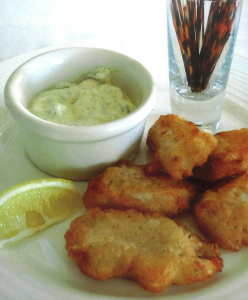 1 cup mayonnaise
1 cup mayonnaise
1/4 cup dill pickle, minced
2 tb lemon juice
1 tb fresh dill
1 1/2 cups flour
1 cup beer
1 ts garlic powder
1/2 teaspoon black pepper
8 fillets lionfish
Oil for frying
Combine first four ingredients in bowl and mix until blended. Combine flour, beer, garlic powder, and pepper in a separate bowl. Cut lionfish fillets into strips. Heat oil in frying pan. When oil is hot, dredge fish through beer batter, covering the entire fish fillet. Put fish into hot oil and cook until the other side is golden brown. Place a paper towel on a plate to absorb excess oil and transfer cooked fish to plate. Serve with dill tartar sauce.
The Lionfish Cookbook
Lemon-Pepper Lionfish
Serves 4
3 tablespoons olive oil
1 pound lionfish filets
1 lemon, juiced
ground black pepper to taste
1. In a large skillet, heat oil over medium high heat until hot.
2. Add fillets and squeeze 1/2 of the lemon’s juice over the tops. Sprinkle with pepper to taste.
3. Lightly sear (about 3 minutes), then turn. Squeeze with the remaining lemon’s juice and sprinkle with pepper to taste. Continue to cook until fillets flake easily with a fork.
More Recipes
How to get your lionfish from ocean to table
Lionfish Stew
Lionfish Nachos



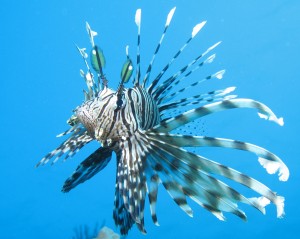
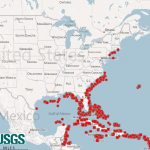
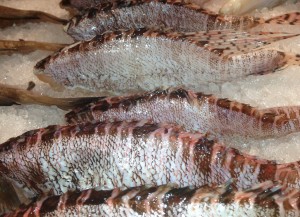


























{ 2 comments… read them below or add one }
hi we are from ballston spa ny we were wondering if we could order lionfish fillets any suggestions email me
Just an update, saw in the paper last week the requirements for a permit to take lionfish has been done away with. “Go get ’em, please and thank you!” seems to be the new normal.